From Love Jihad to Grooming Gangs: Tracing Flows of the Hypersexual Muslim Male through Far-Right Female Influencers
Abstract
:1. Introduction
2. Background
The empowerment and sense of worthiness that is enjoyed by Hindu nationalist women in the public domain should thus be accounted for when compared to their role in the domestic sphere. Due to their welcomed presence in public, Hindu nationalist women have, on multiple occasions, also played a visible role in inciting and participating in violence at rallies, campaigns, and other events (Sarkar 1993, pp. 16–17)—a stark contrast to the submissive homemaker.The imaging of women as mothers of the nation enables Hindu nationalist women, many of whom come from very conservative social backgrounds, to be active outside the immediate confines of their biological families. While their participation in the public sphere might not have been tolerated otherwise, their activism in what has been carefully constructed as a moral/religious movement is deemed not only acceptable but necessary, given their roles as cultural reproducers of the nation.(p. 7)
3. Methodology
4. Data and Findings
4.1. The Case of Nikita Tomar
4.2. Grooming Gang Scandals
By specifying the “violent, brutal rapes and murders of girls,” Sellner reinforces the trope of Muslim male sexuality as predatory and savage. She frames this behaviour along similar lines to the Eurabia theory, a conspiracy that Muslims are seeking the “Islamic penetration of Europe” (Ye’or in Bangstad 2013, p. 371), achieved in part by a demographic takeover. Southern responds by merging this narrative with an anti-immigration stance:Not even just the UK, all across Europe you’ve seen these terrible, just violent, brutal rapes and murders of girls. So, how is this still happening? And why is there not far more outrage about it?
Here, Southern is equating Muslims and Islamic “culture” with “importation”, thereby not only promoting negative stereotypes of Islam as oppressive, but also attributing grooming gang activity as a foreign practice that is connected to sexual slavery. The narrative being promoted is similar to Hindu nationalists positioning Muslims as “foreign” and displaying “anti-national” beliefs and practices. Southern also fails to acknowledge that the grooming gang perpetrators could be British citizens and assumes that immigration status plays a role in their abusive behaviour. This trope is repeated later in their conversation, in which she characterizes Muslims as an essentialist monolith:Not just across Europe, but this is clearly a culture that we’re importing. You see this all across the Middle East and North Africa with these horrible human trafficking rings and rapes … When we import some of these cultures and these criminals to the West, we don’t deal with them the way that we would deal with them if they were members of the United Kingdom or Canada initially, or actual legal citizens.
Sellner responds with fear mongering:This in-group preference culture … There’s communities that are so completely different than Western society, that it’s just the culture there.
Positioning Islamic “culture” as antithetical to the West echoes Huntington’s (1993) clash of civilizations thesis, in which Western and Islamic civilizations will inevitably face conflict; this further builds upon Brubaker’s concept of civilizationalism above. These two far-right female influencers use coded language such as “in-group,” “communities”, and “culture” to frame Muslims as fundamentally “Other”: intolerant and unwilling to assimilate. What constitutes “assimilation” is unclear, although the underlying assumption is that Muslims are distinctly foreign and do not subscribe to Western values. This difference is allegedly manifested as sexual exploitation in grooming gangs.And having them co-exist, it’s only going to end with one side consuming the other, becoming completely dominant. Without assimilation, like having them in and not even requiring that. It’s going to end in disaster, absolute chaos.
Southern similarly attributes the media as responsible for turning a blind eye:[Telford is a government] cover up, particularly a cover up that right-wingers tend to expose. They tend to say, hey look, this multicultural mass migration maybe isn’t all just rose coloured glasses.
Labelling left-wing politics as the “enemy” that influences state and public institutions, such as law enforcement and the media, is a common tactic amongst the far-right. By framing it as a “cover up,” Southern positions herself and Sellner as exposers of “the real story,” revealing to their audience valuable and secretive information. This strategy aligns with what Lewis (2020) describes as micro-celebrity practices of far-right YouTubers who use intimacy techniques to build credibility with their viewers while simultaneously discrediting mainstream media as biased toward “social justice politics” and silencing dissenting voices. Accordingly, Southern and Sellner posture themselves as arbiters of truth who warn of the dire effects of multiculturalism in Western societies, i.e., organized sexual exploitation of young women.The mainstream media have been just as complicit in not talking about it.
Here, “these people” and “they” refers to the left-wing oriented media and political establishment who favoured the intake of refugees into Europe during the crisis of 2015 (again, Southern is falsely conflating the grooming gang perpetrators with refugees). In describing Muslim immigrants as having “authoritarian cultures” that are tolerated by “native” Europeans, she warns that this will eventually accelerate into societal collapse with Islamic barbaric practices of female oppression. This rhetoric of “tolerance” bears striking resemblance to the discourse on “pseudo-secularism” and “minority appeasement” of Hindu nationalists, as highlighted above in Singh’s post on Hindus facing discrimination. Here, we see a dual construction of the majority group, i.e., Hindus and white Europeans, as tropes of victimhood to mobilize outrage (see Ganesh 2020).These people have spent so long saying this was a real refugee crisis. They spent so long saying this multicultural society will work fine, we just have tolerance, we’re not going to have issues with authoritarian cultures, we’re not going to have issues with cultures that are completely antithetical to Western society.
By focusing upon the violation of children and their innocence, Sellner attributes this with the degradation of society. In particular, children symbolise the nuclear family unit as the foundation for a nationalist myth for the far-right. The vulnerability of children places women’s roles as nurturers and men’s role as protectors in far-right reproductive logics, echoing Mattheis’ concept of “alt-maternalism” within alt/far-right communities. Another notable claim in Sellner’s statement is the phrase “worth fighting for.” As noted above, the far-right attributes European men for building Western civilization out of motivation for their women and children; the virtue of white womanhood is threatened by miscegenation and sexual impulses of non-white male migrants (Mattheis 2018, pp. 147–49). This narrative circulates amongst far-right social media accounts, such as the Instagram account worth_fighting_for, shown in Figure 7.I don’t understand why there isn’t more outrage about this, why there isn’t protests in the streets. A society that doesn’t take care of its children, is not a society that’s even worth fighting for.
4.3. Protecting “Our Daughters”
Sellner does not explicitly name the Great Replacement but rather alludes to the phenomenon of Muslims replacing the “native” European population through immigration and demographic warfare—a dog whistle for the Great Replacement. Muslims in particular are identified as a threat to white European populations according to the Identitarian Movement’s interpretation of the Great Replacement theory (Davey and Ebner 2019, p. 7).Aside from the mass Islamization and the risk of terror attacks, are you also concerned about the fact that with so many people migrating, it will eventually replace the population… Muslims will be the majority in Europe. This will replace the culture.
Here, Robinson is attributing Muslim (“they”) reproduction rates as a “weapon” that is being deliberately employed against the European (“we”) population. Citing sensationalist numbers of Muslim family sizes and inaccurate portrayals of polygamous relationships, Robinson engages in fear mongering that “native” Europeans will be eventually “replaced” by an oppressive Islamic regime that treats women as solely reproductive objects. His emphasis on the stealthy nature of this approach echoes the type of “creeping Islamization” or “creeping Sharia” rhetoric popular among the counter-jihad milieu (see Pertwee 2020). At the heart of this Great Replacement conspiracy is the role of Muslim male hypersexuality, which is depicted as barbaric, savage, and tyrannical.When you talk about the Great Replacement … the problems we already face, they’re just going to explode … That should be the biggest fear. The biggest weapon they use is we’re only 5%, we’re only 6%, we’re only small numbers. But they know how quickly it can change. When you have in England—5.6 children, Muslims—in France 7.1, I believe, on average—multiple wives. That can like *snaps fingers*.
By framing non-Muslims as facing persecution, harassment, and an epidemic of rape and violence (i.e., grooming gangs) instigated by Muslims, Robinson paints an urban dystopia, a “violent imaginary” of the far-right, which Thorleifsson (2019) describes as sites “where Muslim immigration has turned neighbourhoods into ghettos, sharia was practised and rape was commonplace” (p. 515). Sellner builds upon this alarmism in her response:Do you think they’ll show us the same rights when they become the majority? Just look in the areas where they have become the majority. Look in Luton, look in Bradford, look in Birmingham. Look at what it’s like for non-Muslims living in those communities. Look at the persecution they face, look at the harassment they face, look at the rapes and the violence they face. We are sleepwalking into an oblivion.
Under “their” (Islamic) rule, practices such as child marriage are viewed as common place, an example of the pedophilia that is supposedly carried out by Muslim men upon vulnerable young victims. This perverse act, manifested in the grooming gang activity above, is seen to be a natural extension of religious practice, as dictated by Islam. Robinson reinforces this point:Absolutely. You also have to consider the things we’ll be subjected to under their rule, like child marriage, for example, which you’ve mentioned is going on in the UK despite being illegal, but it’s still going on.
To which Sellner simply replies:And that’s child marriage between Muslims. When you look at the prostitution of our daughters, which is again scriptured in the Quran, they can take non-Muslim women as sexual slaves.
Robinson agrees:They hate us.
Sellner concludes:They hate us. Or they view our women completely differently. They view our women as fair game.
In depicting Muslim men who seek “our daughters” or “our women” as “sexual slaves” (see Tebaldi in this Special Issue), Robinson reproduces a gendered nationalist imaginary that represents “pure” Western women as being threatened by the hypersexual impulses of Muslim men. When projected as an act of demographic warfare, the fertility of Western women becomes weaponized in policing bodies.The cultures are completely incompatible. And a lot of people won’t admit this.
In positioning Muslims (“they”) versus “natives” (“us”), Sellner constructs a binary of assumed fundamental difference. Robinson replies with a surprising comparison:And then there’s the question of tolerance. Do you believe the Muslims, when they do become the majority, will be as tolerant of the natives as the natives are of them now? And this is I think a very important question to ask, that we need to ask.
By stressing the Indian context, Robinson makes a direct connection between European/North American far-right and Hindu nationalist narratives concerning the role of Islam, and relatedly, how acts of tolerance lead to sexual domination and oppression by Muslims. This is linked to power dynamics over population control, which Robinson refers to as “refugee” status as a consequence of tolerating Islam.Through tolerance we will ourselves become refugees. Just ask people in India, the same situation. Many of them have had to leave due to tolerance to Islam (emphasis added).
Robinson continues by highlighting a solution devised by Ghosh:I’ve heard of the term love jihad. It’s mad cause in our country we have a mass scandal going on, which is grooming … [Love jihad] is exactly the same as what’s happening here. The problems in India, you’re ten or fifteen years ahead of us.
By signalling that young Hindu men must stand together to defend “their” women from threatening Muslim men, Robinson once again frames women as vulnerable “daughters” in need of protection. The female victims are portrayed as naïve, innocent, and with no agency in their decision making regarding romantic relationships. This presents an interesting contrast to the far-right female influencers above, who, despite engaging in similar victimhood narratives, do not explicitly call upon men to take action as protectors of young women. Instead, they encourage their viewers to “make noise” and raise awareness of this issue, indicating that both men and women can collectively play a role in challenging grooming activity. Robinson, on the other hand, promotes men’s sense of ownership and entitlement over “our” women.You’ve set up an organization which has a 100,000 young Hindu men who volunteer to protect your community, to protect your daughters.
5. Discussion
Funding
Institutional Review Board Statement
Informed Consent Statement
Data Availability Statement
Conflicts of Interest
| 1 | https://ishittva.org (accessed on 28 October 2021). |
| 2 | On the other hand, Agarwal does employ more traditional practices of microcelebrity on her Instagram page, posting photos of homecooked Ayurvedic foods, spiritual books she is reading, and practicing meditation. |
| 3 | Video has been taken down from YouTube but is accessible on Brittany’s BitChute channel as “Fighting Islamization with Tommy Robinson,” uploaded 27 October 2017, https://www.bitchute.com/video/6GAi4jiZQB4/ (accessed on 28 October 2021). |
| 4 | See for example, “The Tommy Robinson Interview That Got Me Banned From The U.K.,” 14 March 2018, https://www.youtube.com/watch?v=WnQ3pmDjfkc&t=1s (accessed on 28 October 2021). |
| 5 | “Tommy Robinson and Tapan Ghosh: Islam’s War Against Hinduism in India,” 23 January 2018, https://www.youtube.com/watch?v=MMZjUiJSsQY (accessed on 28 October 2021). |
References
- Abidin, Crystal. 2015. Communicative Intimacies: Influencers and Percieved Interconnectedness. Ada: A Journal of Gender, New Media, and Technology 8: 1–16. [Google Scholar]
- Ahmed, Saifuddin, Jaidka Kokil, and Jaeho Cho. 2016. The 2014 Indian elections on Twitter: A Comparison of Campaign Strategies of Political Parties. Telematics and Informatics 33: 1071–87. [Google Scholar] [CrossRef]
- Bacchetta, Paola. 1993. All Our Goddesses are Armed: Religion, Resistance, and Revenge in the Life of a Militant Hindu Nationalist Woman. Bulletin of Concerned Asian Scholars 25: 38–52. [Google Scholar] [CrossRef]
- Bangstad, Sindre. 2013. Eurabia Comes to Norway. Islam and Christian–Muslim Relations 24: 369–91. [Google Scholar] [CrossRef]
- Bangstad, Sindre. 2019. Bat Ye’or and Eurabia. In Key Thinkers of the Radical Right. Edited by Mark Sedgwick. Oxford: Oxford University Press, pp. 170–84. [Google Scholar] [CrossRef]
- Bar-On, Tamir. 2007. Where Have All the Fascists Gone? London: Routledge. [Google Scholar] [CrossRef]
- Bhatt, Chethan. 2004. Democracy and Hindu Nationalism. Democratization 11: 133–54. [Google Scholar] [CrossRef]
- Blee, Katheleen M. 2002. Inside Organized Racism: Women in the Hate Movement. Berkeley: University of California Press. [Google Scholar]
- Brubaker, Rogers. 2017. Between Nationalism and Civilizationism: The European Populist Moment in Comparative Perspective. Ethnic and Racial Studies 40: 1191–226. [Google Scholar] [CrossRef]
- Chadha, Kalyani, and Pallavi Guha. 2016. The Bharatiya Janata Party’s Online Campaign and Citizen Involvement in India’s 2014 Election. International Journal of Communication 10: 4389–406. [Google Scholar]
- Chakravartty, Paula, and Srirupa Roy. 2015. Mr. Modi Goes to Delhi: Mediated Populism and the 2014 Indian Elections. Television and New Media 16: 311–22. [Google Scholar] [CrossRef]
- Cockbain, Ella, and Waqas Tufail. 2020. Failing Victims, Fuelling Hate: Challenging the Harms of the ‘Muslim Grooming Gangs’ Narrative. Race & Class 61: 3–32. [Google Scholar] [CrossRef] [Green Version]
- Darby, Sayward. 2020. Sisters in Hate: American Women on the Front Lines of White Nationalism. New York: Little, Brown and Company. [Google Scholar]
- Davey, Jacob, and Julia Ebner. 2019. ‘The Great Replacement’: The Violent Consequences of Mainstreamed Extremism. London: Institute for Strategic Dialogue, Available online: https://www.isdglobal.org/wp-content/uploads/2019/07/The-Great-Replacement-The-Violent-Consequences-of-Mainstreamed-Extremism-by-ISD.pdf (accessed on 28 October 2021).
- Dietze, Gabriele, and Julia Roth. 2020. Right-Wing Populism and Gender: European Perspectives and Beyond. Bielefeld: transcript Verlag. [Google Scholar] [CrossRef]
- Farris, Sara R. 2017. In the Name of Women’s Rights: The Rise of Femonationalism. Durham: Duke University Press. [Google Scholar]
- Ganesh, Bharath. 2020. Weaponizing white thymos: Flows of rage in the online audiences of the alt-right. Cultural Studies 34: 892–924. [Google Scholar] [CrossRef]
- Govil, Nitin, and Anirban Kapil Baishya. 2018. The Bully in the Pulpit: Autocracy, Digital Social Media, and Right-wing Populist Technoculture. Communication Culture and Critique 11: 67–84. [Google Scholar] [CrossRef]
- Huntington, Samuel. 1993. The Clash of Civilizations? Foreign Affairs 72: 22–49. [Google Scholar] [CrossRef]
- Köttig, Michaela, Renate Bitzan, and Andrea Petö, eds. 2017. Gender and Far Right Politics in Europe. London: Palgrave Macmillan. [Google Scholar]
- Leidig, Eviane. 2020a. Hindutva as a variant of right-wing extremism. Patterns of Prejudice 54: 215–37. [Google Scholar] [CrossRef]
- Leidig, Eviane. 2020b. From cyber-Hindutva to Ab Ki Baar Trump Sarkar: (Trans)national entanglements of Hindu diaspora political integration. In Political Integration in Indian Diaspora Societies. Edited by Ruben Gowricharn. London: Routledge, pp. 127–52. [Google Scholar]
- Lewis, Rebecca. 2018. Alternative Influence: Broadcasting the Reactionary Right on YouTube. New York: Data & Society Research Institute. [Google Scholar]
- Lewis, Rebecca. 2020. “This is what the news won’t show you”: YouTube Creators and the Reactionary Politics of Micro-Celebrity. Television & New Media 21: 201–17. [Google Scholar] [CrossRef]
- Maly, Ico. 2020. Metapolitical New Right Influencers: The Case of Brittany Pettibone. Social Sciences 9: 113. [Google Scholar] [CrossRef]
- Marwick, Alice E. 2015. Instafame: Luxury Selfies in the Attention Economy. Public Culture 27: 137–60. [Google Scholar] [CrossRef] [Green Version]
- Mattheis, Ashley. 2018. Shieldmaidens of Whiteness: (Alt) maternalism and Women Recruiting for the Far/Alt-Right. Journal for Deradicalization 17: 128–62. [Google Scholar]
- Menon, Kalyani Devaki. 2010. Everyday Nationalism. Philadelphia: University of Pennsylvania Press. [Google Scholar]
- Mohan, Sriram. 2015. Locating the “Internet Hindu”: Political Speech and Performance in Indian Cyberspace. Television and New Media 16: 339–45. [Google Scholar] [CrossRef]
- Mondon, Aurelien, and Aaron Winter. 2017. Articulations of Islamophobia: From the extreme to the mainstream? Ethnic and Racial Studies 40: 2151–79. [Google Scholar] [CrossRef]
- Pal, Joy. 2015. Banalities Turned Viral: Narendra Modi and the Political Tweet. Television and New Media 16: 378–87. [Google Scholar] [CrossRef]
- Pertwee, Ed. 2020. Donald Trump, the Anti-Muslim Far Right and the New Conservative Revolution. Ethnic and Racial Studies 43: 211–30. [Google Scholar] [CrossRef] [Green Version]
- Pilkington, Hilary. 2017. ‘EDL angels stand beside their men… not behind them’: The Politics of Gender and Sexuality in an anti-Islam (ist) Movement. Gender and Education 29: 238–57. [Google Scholar] [CrossRef]
- Sarkar, Tanika. 1993. The Women of the Hindutva Brigade. Bulletin of Concerned Asian Scholars 25: 16–24. [Google Scholar] [CrossRef]
- Saxena, Saumya. 2018. “Court”ing Hindu Nationalism: Law and the Rise of Modern Hindutva. Contemporary South Asia 26: 378–99. [Google Scholar] [CrossRef]
- Sethi, Manisha. 2002. Avenging Angels and Nurturing Mothers: Women in Hindu Nationalism. Economic and Political Weekly 37: 1545–52. [Google Scholar]
- Šima, Karel. 2021. From Identity Politics to the Identitarian Movement. In National Stereotyping, Identity Politics, European Crises. Edited by Jürgen Barkhoff and Joep Leerssen. Leiden: Brill. [Google Scholar] [CrossRef]
- Spierings, Niels, Andrej Zaslove, Liza M. Mügge, and Sarah L. de Lange. 2015. Gender and Populist Radical-Right Politics: An Introduction. Patterns of Prejudice 49: 3–15. [Google Scholar] [CrossRef]
- Thobani, Sitara. 2019. Alt-Right with the Hindu-Right: Long-distance Nationalism and the Perfection of Hindutva. Ethnic and Racial Studies 42: 745–62. [Google Scholar] [CrossRef]
- Thorleifsson, Cathrine. 2019. The Swedish Dystopia: Violent Imaginaries of the Radical Right. Patterns of Prejudice 53: 515–33. [Google Scholar] [CrossRef]
- Udupa, Sahana. 2018. Enterprise Hindutva and Social Media in Urban India. Contemporary South Asia 26: 453–67. [Google Scholar] [CrossRef]
- Youmans, William Lafi, and Jillian C. York. 2012. Social Media and the Activist Toolkit: User Agreements, Corporate Interests, and the Information Infrastructure of Modern Social Movements. Journal of Communication 62: 315–29. [Google Scholar] [CrossRef]
- Zúquete, José Pedro. 2018. The Identitarians: The Movement against Globalism and Islam in Europe. Notre Dame: University of Notre Dame Press. [Google Scholar] [CrossRef]
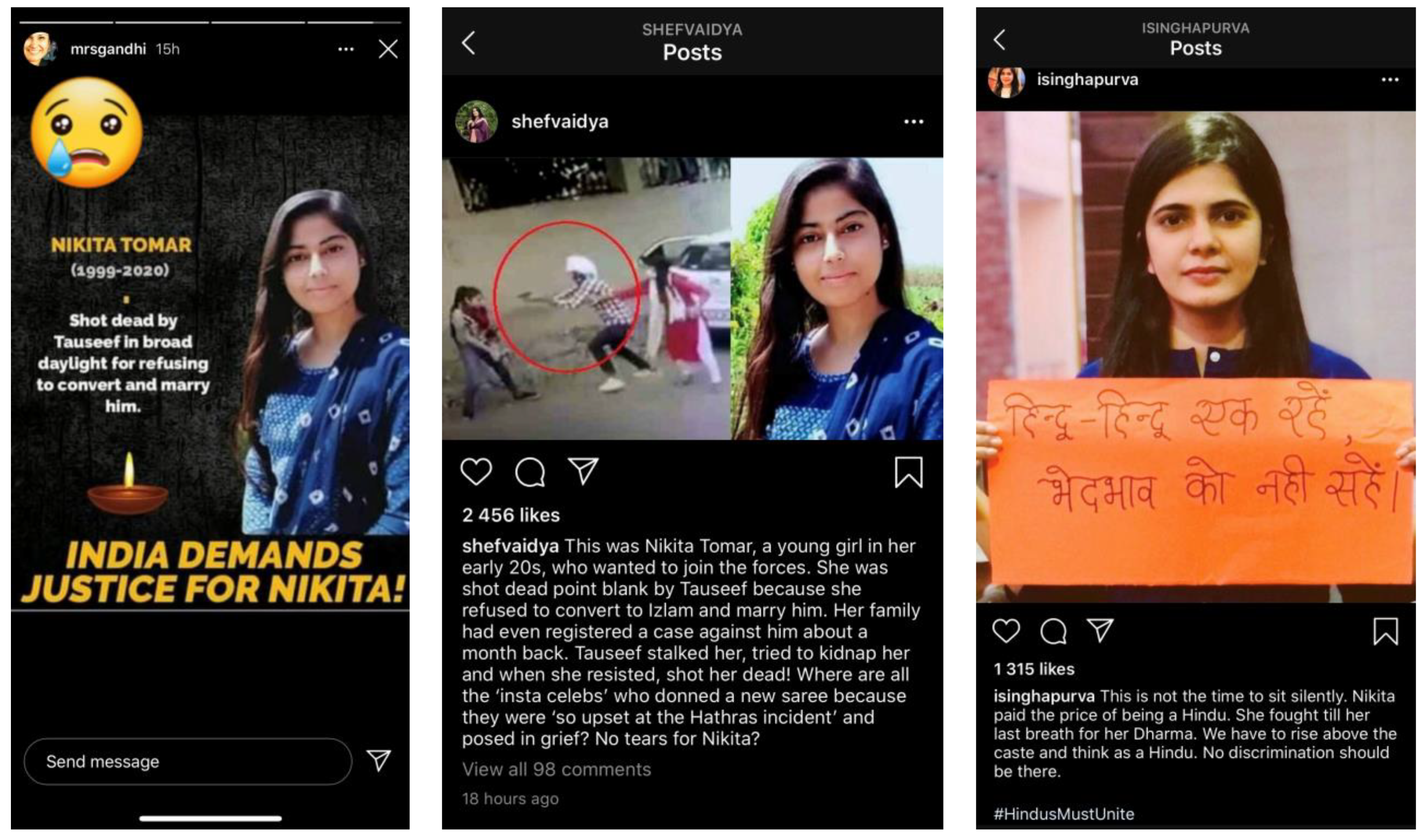
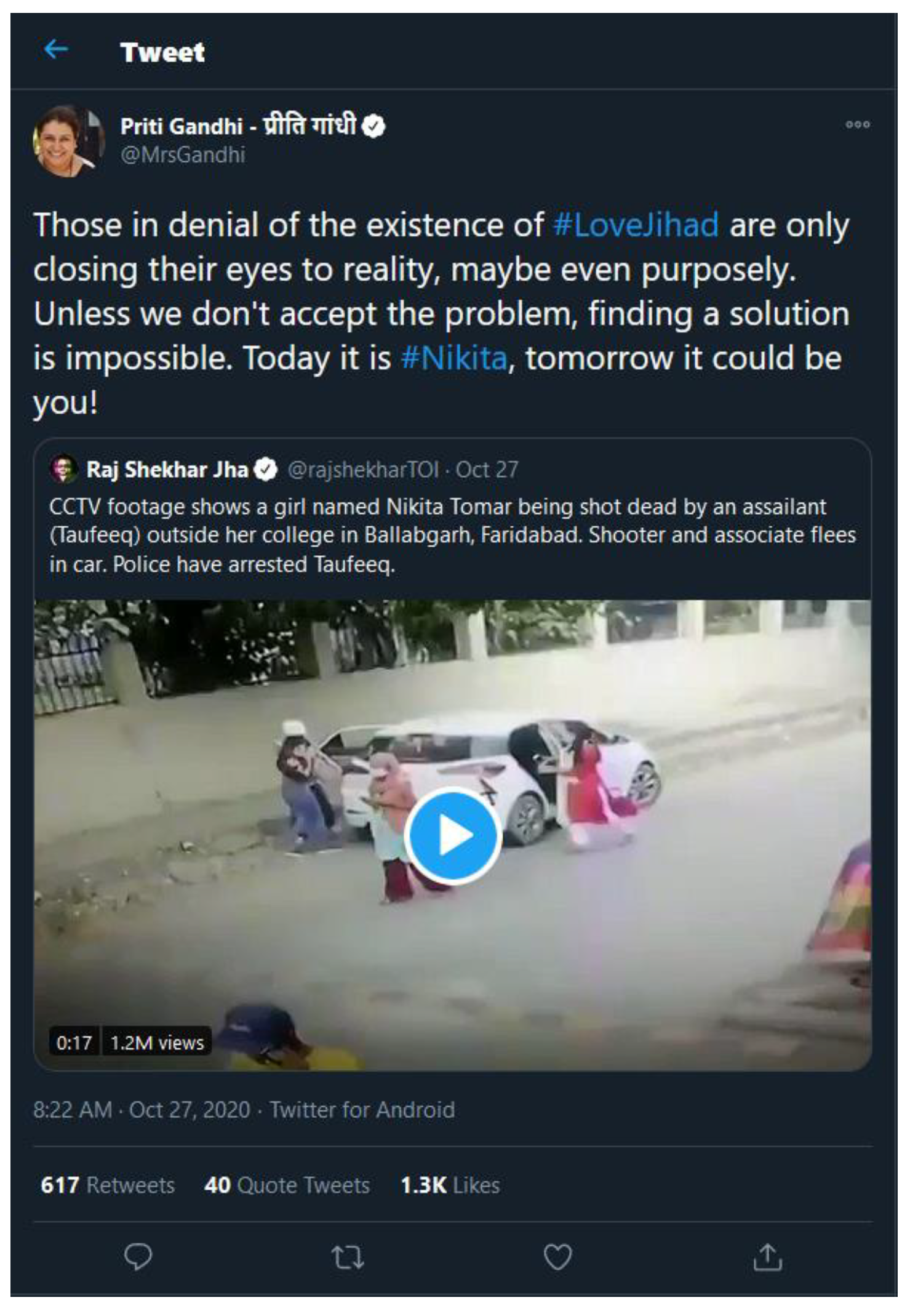
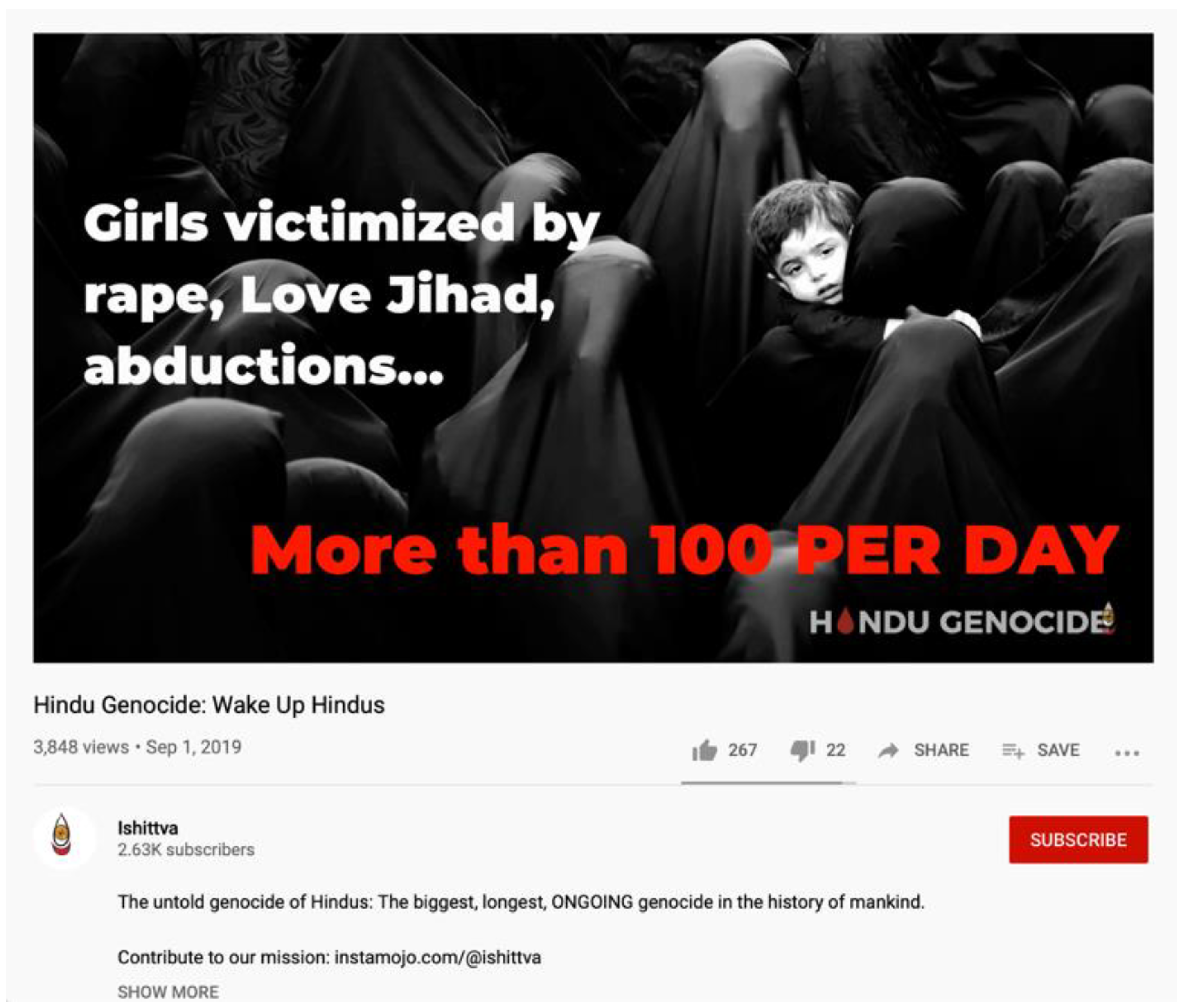
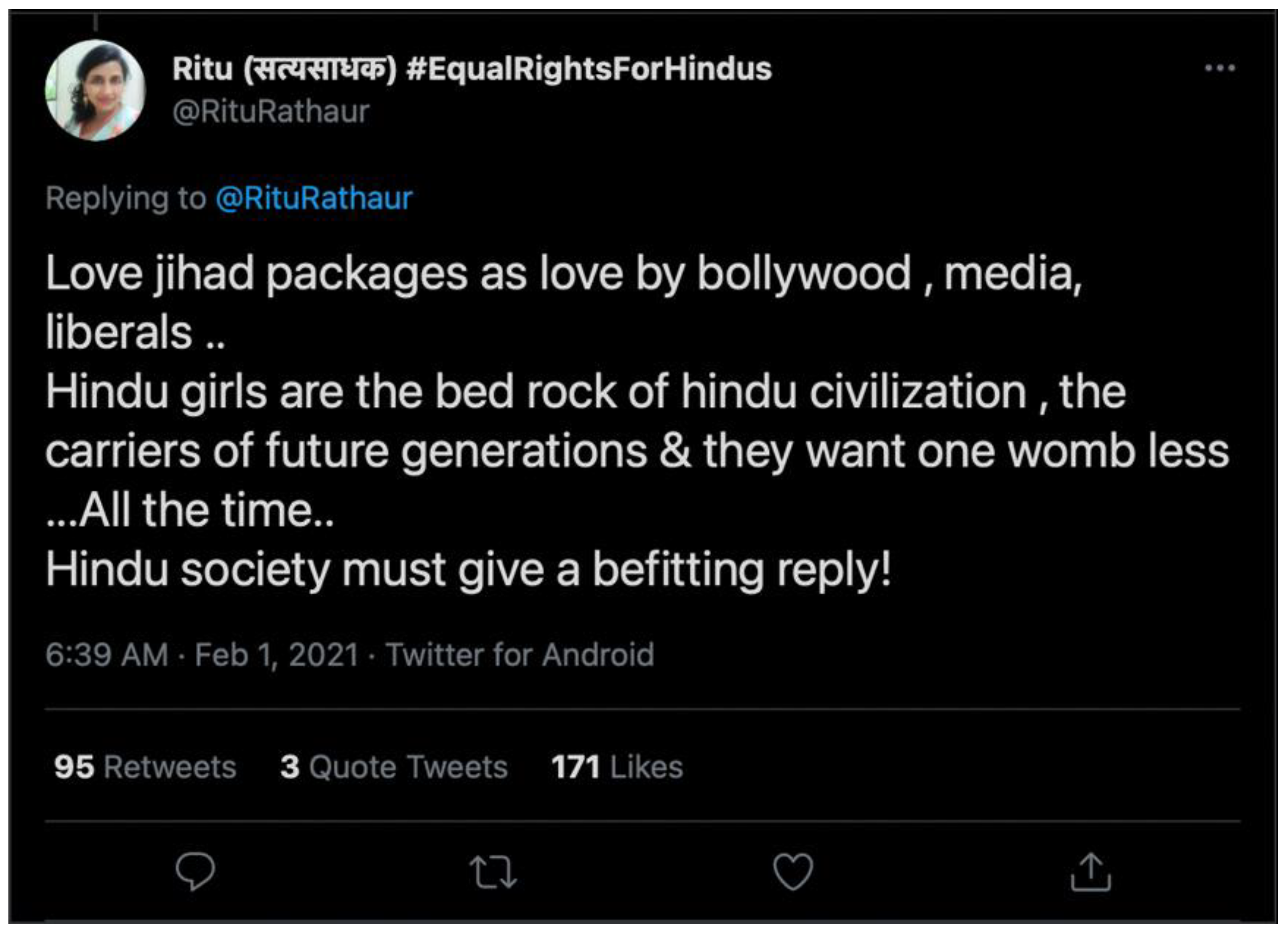





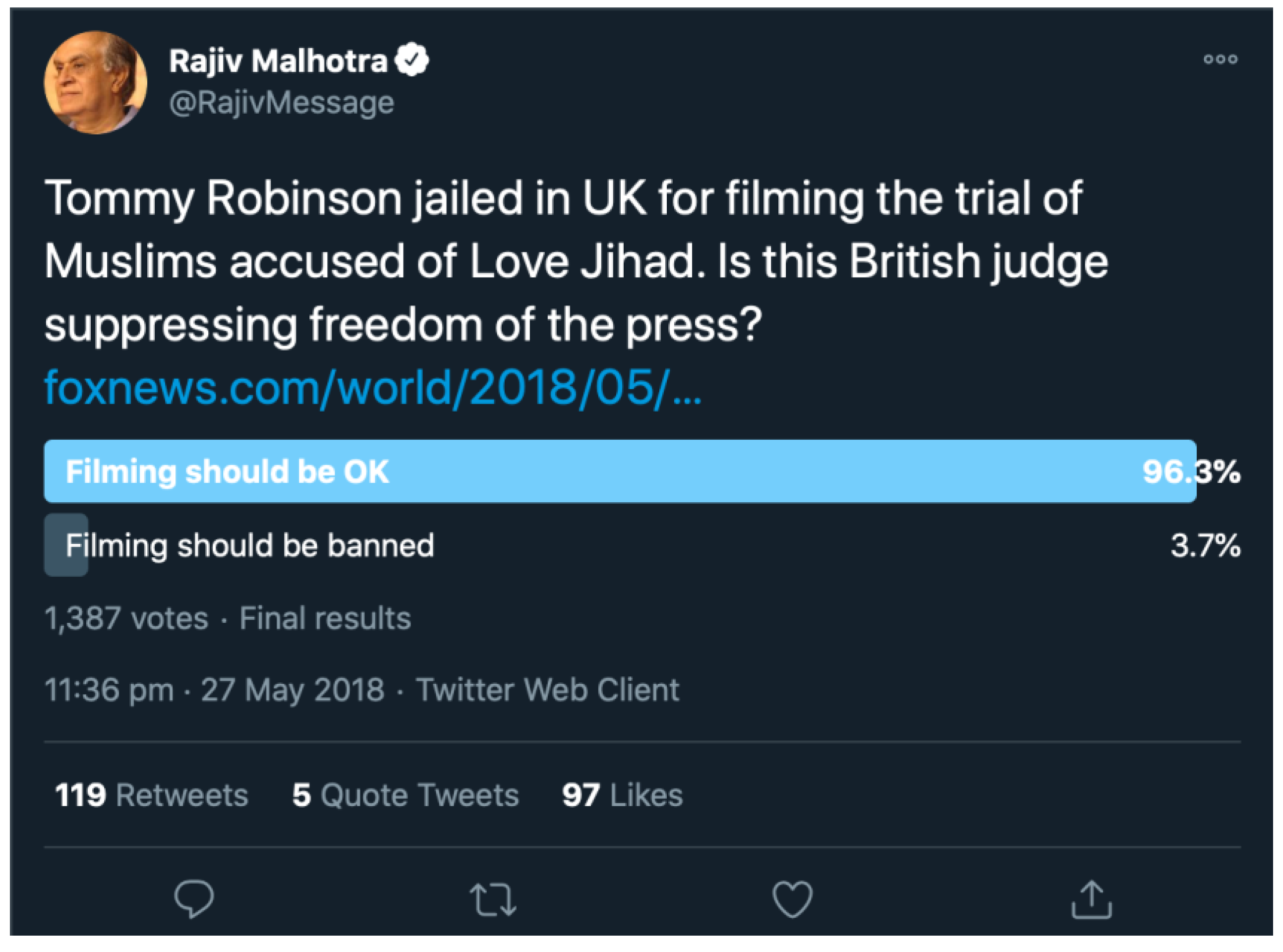
Publisher’s Note: MDPI stays neutral with regard to jurisdictional claims in published maps and institutional affiliations. |
© 2021 by the author. Licensee MDPI, Basel, Switzerland. This article is an open access article distributed under the terms and conditions of the Creative Commons Attribution (CC BY) license (https://creativecommons.org/licenses/by/4.0/).
Share and Cite
Leidig, E. From Love Jihad to Grooming Gangs: Tracing Flows of the Hypersexual Muslim Male through Far-Right Female Influencers. Religions 2021, 12, 1083. https://doi.org/10.3390/rel12121083
Leidig E. From Love Jihad to Grooming Gangs: Tracing Flows of the Hypersexual Muslim Male through Far-Right Female Influencers. Religions. 2021; 12(12):1083. https://doi.org/10.3390/rel12121083
Chicago/Turabian StyleLeidig, Eviane. 2021. "From Love Jihad to Grooming Gangs: Tracing Flows of the Hypersexual Muslim Male through Far-Right Female Influencers" Religions 12, no. 12: 1083. https://doi.org/10.3390/rel12121083
APA StyleLeidig, E. (2021). From Love Jihad to Grooming Gangs: Tracing Flows of the Hypersexual Muslim Male through Far-Right Female Influencers. Religions, 12(12), 1083. https://doi.org/10.3390/rel12121083




